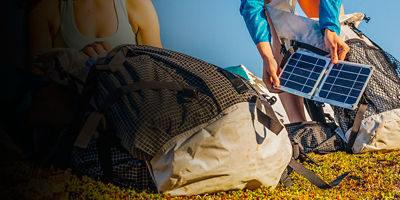Radios
Radio communicators send and receive frequencies—some need licensing to operate, and others are regulated by law. With several types of radios on the market, learn what’s what, and which might be best for your needs.
FRS (Family Radio Service)
Designed for the casual or new two-way radio user, FRS systems are great for folks who want to communicate in close range (one mile, or less depending on terrain) outdoors and learn the basics of radio systems. If you’re not trying to touch base with a partner in a different mountain range, on a ship at sea, or underground in a cave, the FRS is likely the best place to start.
Pros: Doesn’t require licensing from the FCC; great battery life
Cons: Short communication range; sound can be staticky
GMRS (General Mobile Radio Service)
A GMRS radio has all the same capabilities as an FRS radio and then some. While requiring a license from the FCC, GMRS accesses special radio channels that FRS can’t access, providing an uncluttered and clear communication space in areas with more competition for a signal. With up to 5 watts of power, handheld GMRS will reach up to 2 miles, and mobile units can go up to 5 miles with an antenna.
Pros: Uses unique frequencies that don’t conflict with emergency or other recreational walkie-talkies; can reach longer distances than FRS and CB; less static than FRS
Cons: Requires licensing from the FCC; signals shorter than Ham radios
CB, or Citizens Band, Radio
These radios allow short-distance person-to-person bi-directional voice communication. To mount a CB on your rig, installation includes the main radio body and head unit, antenna cable, antenna, and antenna mount (CB antennas need to be a minimum of 102 inches long to work well). Handheld versions also exist but aren’t as powerful or clear as mounted versions. As required by law, all CB radios transmit with the same 4 watts of power. (Note: Radios equipped with Single Side Bands (SSB) let you transmit at 12 watts of power instead of 4 watts, effectively tripling the transmission range. However, for others to hear and reply to your transmissions, they too will need an SSB equipped radio. That said, all SSB radios can operate on standard CB channels, at the regular 4 watts.)
Pros: Doesn’t require licensing from the FCC
Cons: Capped at 4 watts of power; range is a quarter- to a half-mile in hilly terrain; requires hardware installation; requires a long antenna, with fewer options for mounting
Ham Radios
With the ability to access higher frequencies, ham radios are more reliable at longer distances and in more complex terrain. Most hard-wired mobile ham radios (that you might install in your rig) operate at 50 watts, and most handheld ham radios operate at 4 to 5 watts, though it’s possible to crank them up to operate at up to 1500W, according to regulations—operating at such a power output will quickly drain your battery, so beware. Ham radios can operate VHF (very high frequency) or UHF (ultra high frequency) systems, and in either case require an antenna with a minimum length of 19.5 inches for good signal.
Pros: Capped at 1500W of power; requires a 19.5-inch-minimum antenna (more options for mounting); VHF works best over mountains and hills; UHF works better and goes farther over deserts or flat land or water; can tap into the wide range of repeaters (which rebroadcast and strengthen original signals) that exist around the world
Cons: Requires licensing from the FCC; larger radio systems require mounting and take up more space; can be pricey, but some economical options exist
In general, look for durable materials in your walkie-talkies; consider water and dirt resistance; and evaluate battery life (plus how the battery will perform in the cold/heat). Pro tip: For climbing or ski-mountaineering, look for smaller, lightweight or handheld two-way radios to talk to your partner a rope’s length away, or to your base camp team on the ground.
Satellite Communicators
When you’ll be far away (out of radio range) from the party you need to communicate with, you’ll need to use a satellite communicator. These units can also help you get assistance in the case of emergencies and informational updates like weather forecasts. Lightweight, handheld GPS units are perfect for the backcountry and let you communicate not only SOS messages to emergency service providers, but also messages to loved ones or crew members. Some even allow you to receive messages as well. You’ll have to pay for all those global services though, with a more expensive up-front cost for the unit, often with subscription fees to operate as well.























